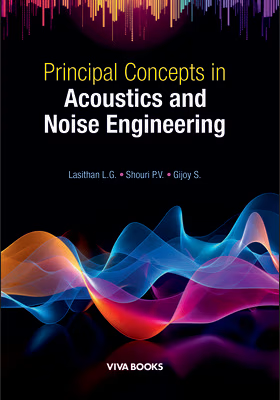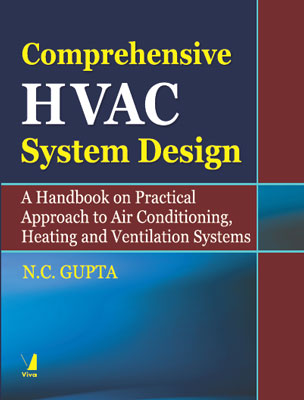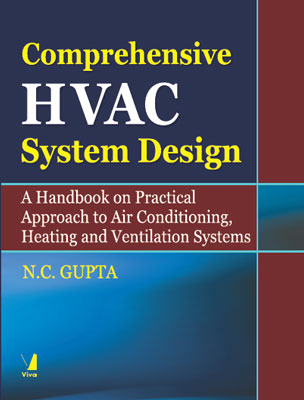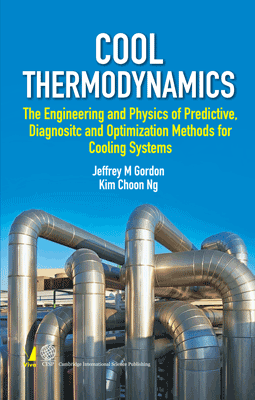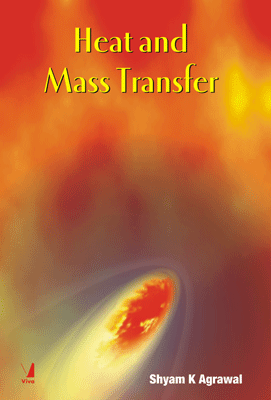Buy Fundamentals of Acoustics & Noise Engineering Books
Principal Concepts in Acoustics and Noise Engineering
₹1,165.50 ₹1,295.00 Save: ₹129.50 (10%)
Go to cartISBN: 9789360335229
Bind: Paperback
Year: 2026
Pages: 314
Size: 6.75 x 9.5 Inch
Publisher: Viva Books Originals
Sales Territory: Worldwide
Description:
Principal Concepts in Acoustics and Noise Engineering is a comprehensive textbook offering both fundamental and advanced insights into acoustics and noise control. It presents a balanced approach between theoretical foundations and real-world applications. The content is organized to systematically address sound propagation, measurement, and control.
The book begins with basic acoustic principles and terminology, gradually progressing to advanced topics such as the acoustic wave equation, spherical wave behaviour, sound radiation, and transmission through different media. It also explores the human auditory system, covering hearing mechanisms, loudness perception, and hearing impairment.
Detailed coverage is provided on noise measurement methods, evaluation standards, and regulatory guidelines relevant to industrial, environmental, and occupational noise. The text discusses various noise control techniques implemented at the source, along the transmission path, and at the receiver, with emphasis on solutions for machinery noise including acoustic enclosures, passive mufflers, and active noise control systems.
The final section addresses room acoustics, focusing on sound reflection, absorption, reverberation, and acoustic design principles for spaces such as classrooms, studios, and auditoriums, offering guidance on enhancing acoustic quality in built environments.
Featuring clear explanations, well-structured content, illustrations, and end-of-chapter questions, Principal Concepts in Acoustics and Noise Engineering serves as a thorough resource for developing a deep understanding of acoustics and noise engineering.
Target Audience:
The book serves as a thorough resource for developing a deep understanding of acoustics and noise engineering. It will be immensely useful to students of mechanical engineering, acoustics, and noise engineering.
Contents:
Preface
Acknowledgements
1. Sound Propagation, Acoustic Terminology and Decibel Scales • Sound and its Propagation • Terminology • Acoustics • Acoustic Pressure • Speed of Sound • Frequency • Wavelength and Wave Number • Pure Tone • Particle Velocity • Acoustic Impedance • Acoustic Intensity • Acoustic Energy Density • Decibel Scales • Addition, Subtraction and Averaging of Decibels • Questions • Bibliography
2. Acoustic Wave Equation • One-dimensional Wave Equation • Complex Number Notation • Solution of Acoustic Wave Equation • Questions • Bibliography
3. Spherical Wave and Sound Radiation • Expressing the Inverse Square Law in Decibels • Spherical Waves • Simple Source (Point Source) • Introduction to Polar Coordinates and Polar Grid • Directivity • Directivity Pattern • Beam Width • Directivity Factor and Directivity Index • Directional Pressure Distribution Function • A Vibrating Piston Mounted in a Rigid Baffle • Questions • Bibliography
4. Transmission of Sound • Sound Transmission from One Medium to Another with Normal Incidence • Sound Transmission from One Medium to Another with Oblique Incidence • Transmission of Sound Through Three Different Media • Transmission and Reflection of Sound in Pipes • Standing Waves • Resonators • Helmholtz Resonator • Sound Absorption Coefficients • Questions • Bibliography
5. Human Hearing, Loudness, and Sound Adaptation • Structure of Human Ear and Functions • Subjective and Objective Assessment of Sound • Hearing Threshold • Octave Band Analysis • Loudness and its Psychophysical Indices • Threshold of Hearing and Threshold of Pain • Determination of the Loudness of the Given Composite Sound in Sones and Phons • Sound Level Frequency Weightings: A, B, C, and D • Hearing Loss • Loudness Adaptation • Questions • Bibliography
6. Noise Levels, Criteria, and Standards • Speech Interference Level • Perceived Noise Level • Effective Perceived Noise Level • Determination of the Noisiness of the Given Composite Sound in noys and PNdB • Noise and Number Index (NNI) • Noise Criteria for Interior Spaces • Noise Criteria (NC) Curves • Preferred Noise Criterion Curves • Balanced Noise Criterion Curves • Percentile Sound Pressure Levels • Industrial Noise Criteria • EPA Criteria • HUD Criteria • Traffic Noise Assessment • Human Reaction to Noise • Guidelines for Designing Quieter Machines • Questions • Bibliography
7. Noise Measurement • Microphones • Condenser Microphones • Electrodynamic Microphones • Piezoelectric Microphones • Microphones: Directivity, Linearity, Frequency Response and Dynamic Range • Sound Level Metre • Sound Intensity Probes • Noise Exposure Level and Dosimetre for Occupational Organizations • Noise Exposure Level • Noise Dosimetre • Spectrum Analysis • Measurement of Sound Power • Measurement of Sound Power in a Reverberation Chamber • Measurement of Sound Power in an Anechoic Chamber • Measurement of the Directivity Factor • Questions • Bibliography
8. Noise Control • Airborne, and Structure-borne Noises • Passive and Active Noise Control • Source–Path–Receiver Model • Noise Control at the Source • Noise Control Along the Transmission Path • Noise Control at the Receiver • Questions • Bibliography
9. Noise Control at the Source in Industrial Machinery • Fan Noise • Electric Motor Noise • Pump Noise • Compressor Noise • Cooling Tower Noise • Valve Noise • Questions • Bibliography
10. Noise Control Along the Path and at the Receiver • Noise Control Along the Path • Vibration Isolation • Sound Absorbing Materials • Enclosures • Acoustic Barriers • Damping Materials • Reactive and Dissipative Mufflers • Acoustic Filters • Plenum Chambers • Noise Control at the Receiver • Hearing Protectors • Active Noise Control • Questions • Bibliography
11. Passive Mufflers and Performance • Types of Mufflers • Muffler Performance Indicators • Transfer Matrix Method in Muffler Design • Muffler Elements • Acoustic Impedance, Resistance and Reactance • Side-branch Mufflers – Helmholtz Resonator • Expansion Chamber Mufflers • Dissipative Mufflers • Plenum Chambers • Questions • Bibliography
12. Room Acoustics • Sound Reflection, Transmission and Absorption • Surface-based Sound Absorption • Methods in Room Acoustics • The Geometric or Ray (or Beam) Tracing Approach • The Wave Theory Approach • The Statistical Approach • Exploring the Transient Response in Sabine Acoustics • Sabine’s Acoustic Theory in Steady-State Conditions • Measurement of Reverberation Time • Measurement of Random Incidence Absorption in Reverberation Room • Impedance Tube • Standing Waves in a Room • Room Design for Effective Acoustic Quality • Questions • Bibliography
Appendix
About the Authors:
Lasithan L. G. holds a Ph.D. in Engineering from APJ Abdul Kalam Technological University, Kerala, awarded in June 2023. He earned his M.Tech. in Engineering Statistics from Cochin University of Science and Technology in May 2004, and a B.Tech. in Mechanical Engineering from the College of Engineering, Trivandrum, in April 2000. Dr Lasithan L. G. is an Assistant Professor of Mechanical Engineering at Government Engineering College, Kozhikode, with over 18 years of teaching and 8 years of research experience. His areas of expertise include reliability engineering, machine failure analysis, and maintenance engineering.
Shouri P. V. holds a Ph.D. in Engineering from Cochin University of Science and Technology, awarded in 2008. He obtained his M.Tech. in Thermal Sciences from NIT Kozhikode in 1995 and a B.E. in Mechanical Engineering from Mangalore University in 1992. Dr Shouri P. V. is currently an Associate Professor of Mechanical Engineering at Government Model Engineering College, Cochin, Kerala. He has been actively involved in teaching and research since the mid-1990s. His areas of interest include thermal engineering, energy management, and reliability engineering.
Gijoy S. is an Assistant Professor in the Department of Mechanical Engineering at the College of Engineering, Trivandrum, under the Technical Education Department, Government of Kerala. With over 15 years of teaching experience, he specializes in thermal sciences, renewable energy systems, and sustainable materials. He holds a Ph.D. in Mechanical Engineering from the University of Kerala (2020), an M.Tech. in Mechanical Engineering with a
specialization in Industrial Refrigeration and Cryogenic Engineering from the University of Kerala (2009), and a B.Tech. in Mechanical Engineering from Cochin University of Science and Technology (2007).
